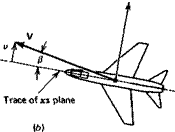Axes and Notation
In this book the Earth is regarded as flat and stationary in inertial space. Any coordinate system, or frame of reference, attached to the Earth is therefore an inertial system, one in which Newton’s laws are valid. Clearly we shall need such a reference frame when we come to formulate the equations of motion of a flight vehicle. We denote that frame by FE(0E, xE, yE, zE)- Its origin is arbitrarily located to suit the circumstances of the problem, the axis 0EzE points vertically downward, and the axis 0ExE, which is horizontal, is chosen to point in any convenient direction, for example, North, or along a runway, or in some reference flight direction. It is additionally assumed that gravity is uniform, and hence that the mass center and center of gravity (CG) are the same point. The location of the CG is given by its Cartesian coordinates relative to Fb. Its velocity relative to FE is denoted V’ and is frequently termed the groundspeed.
![Axes and Notation Подпись: Figure 1.6 Notation for body axes. L = rolling moment, M = pitching moment, N = yawing moment, p = rate of roll, q = rate of pitch, r = rate of yaw. [X, K, Z| = components of resultant aerodynamic force. u. v, w] = components of velocity of C relative to atmosphere.](/img/3129/image010_4.gif) |
Aerodynamic forces, on the other hand, depend not on the velocity relative to FE, but rather on the velocity relative to the surrounding air mass (the airspeed), which will differ from the groundspeed whenever there is a wind. If we denote the wind velocity vector relative to FE by W, and that of the CG relative to the air by V then clearly
V£ = V + W (1.6,1)
The components of W in frame FE, that is, relative to Earth, are given by
w£ = [Wx Wy Wzf (1.6,2)
V represents the magnitude of the airspeed (thus retaining the usual aerodynamics meaning of this symbol). For the most part we will have W = 0, making the airspeed the same as the inertial velocity.
 |
 |
A second frame of reference will be needed in the development of the equations of motion. This frame is fixed to the airplane and moves with it, having its origin C at the CG, (see Fig. 1.6). It is denoted FB and is commonly called body axes. Cxz is the plane of symmetry of the vehicle. The components of the aerodynamic forces and moments that act on the airplane, and of its linear and angular velocities relative to
Figure 1.7 (a) Definition of ax. (b) View in plane of у and V, definition of /3.
the air are denoted by the symbols given in the figure. In the notation of Appendix A. 1, this means, for example, that
VB = [u v w]r (1-6,3)
The vector V does not in general lie in any of the coordinate planes. Its orientation is defined by the two angles shown in Fig. 1.7:
 Angle of attack, ax = tan’
Angle of attack, ax = tan’
Angle of sideslip, /3 = sin
With these definitions, the sideslip angle {3 is not dependent on the direction of Cx in the plane of symmetry.
The symbols used throughout the text correspond generally to current usage and are mainly used in a consistent manner.











